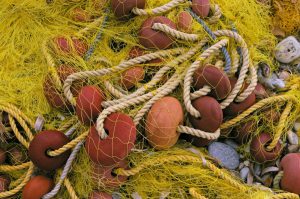
*The following blog post is an excerpt from the book Twenty-Two Fantastical Facts about Dolphins*
Being an air-breathing animal living in the ocean brings with it a number of challenges. Chief among them is trying not to drown. The paradox/problem of living in an aquatic environment but needing to be at the surface to breathe is something that manatees, sea turtles, whales, and dolphins have to cope with on a daily basis. But for dolphins, drowning in the traditional sense (which involves inhaling water into your lungs) is not really the problem.
Dolphins, you see, are sort of immune to drowning.
I know what you’re thinking. This sounds like crazy nonsense. Don’t hundreds of thousands of dolphins drown in fishing nets each year? Well yes, a huge number of dolphins are killed by fishing nets each year. But no, most dolphins trapped in nets don’t drown.
They suffocate.
What’s the difference? It all has to do with what’s happening with a dolphin’s blowhole when they are trapped under water. Dolphins are conscious breathers. This means that a dolphin must think about and decide on every breath it takes. Humans, in contrast, have the ability to let our brainstem take over the breathing duties, allowing us to continue to take breaths even when unconscious or asleep. Dolphins do not have this luxury.
This conscious-breathing setup means dolphins have evolved a strange relationship with their blowholes. A dolphin’s blowhole – which is the only pathway to a dolphin’s lungs – is closed by a sort of flap, which is attached to a very strong set of muscles. When closed, this flap creates a water-tight seal. The blowhole flap remains – by default – in the closed position. Below the blowhole are a series of internal flaps, valves, and other fleshy portals all of which create their own airtight seals – essentially creating four separate barriers between the outside air and a dolphin’s lungs. So if a dolphin is just hanging about in the ocean not thinking about taking a breath, it doesn’t have to worry about letting water into its lungs – the blowhole and other muscle-seals are tightly shut, and waiting on orders from the dolphin’s conscious mind to open up and let in air.
This means that if a dolphin were to ever be knocked unconscious, he/she would sink to the seafloor, and come to rest at the bottom with their blowhole firmly shut. Should the dolphin fail to awaken before they run out of oxygen, they will die – not from drowning (that is, inhaling water), but from suffocation.
Something similar happens if a dolphin were to be trapped in a fishing net. Humans, when trapped under water and in desperate need of air, will almost always open their mouths and make one final, desperate attempt to breathe, sucking water into their lungs. It is rare for a human to suffocate under water without taking a final breath that fills their lungs with water.
A dolphin, on the other hand, is far less likely to inhale water this way. Although they might crave air just as desperately as a human, the blowhole and sphincter-seal system in their nasal cavity typically remains in the default, shut position. 
Occasionally, dolphins that are sick might accidentally inhale water and drown if they are too weak to keep their heads above water. And some dolphins trapped in nets are so overcome by panic that they are able to override the seal-system and open their blowholes, allowing water into their lungs.
But it is likely that most dolphins trapped in a net will ultimately succumb to suffocation as they run out of oxygen, and die with their blowhole closed. This is a terrible, if all too common fate for a dolphin, or any other air-breathing sea creature.
